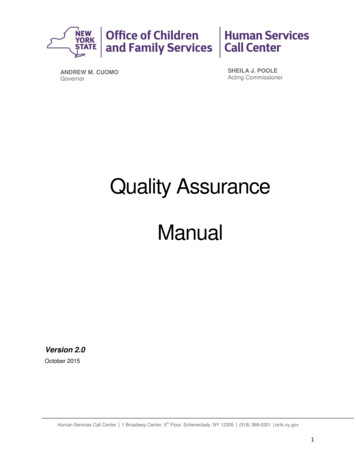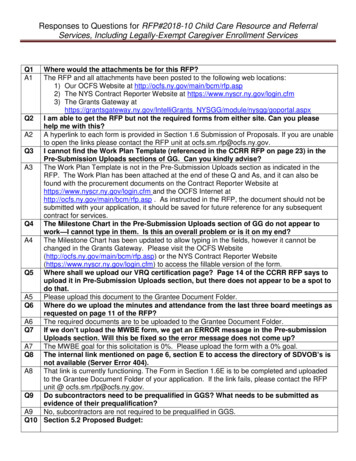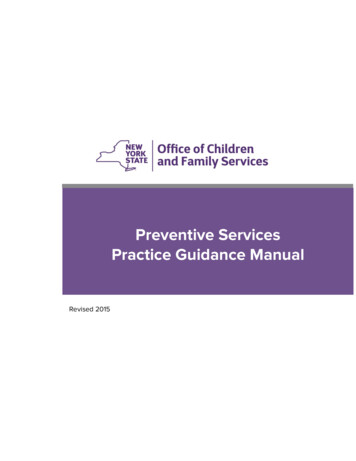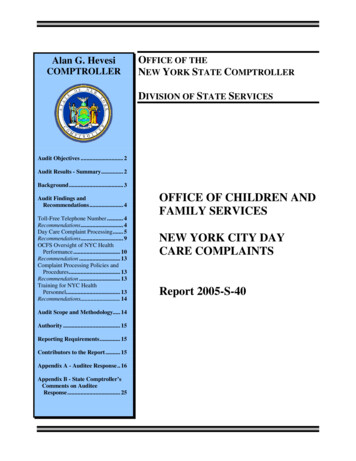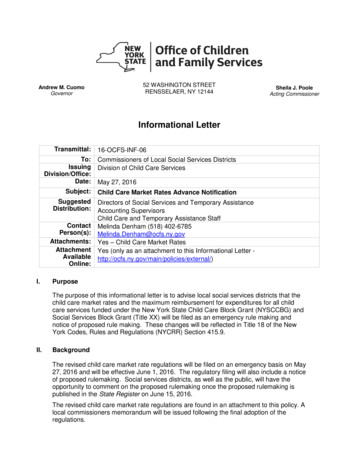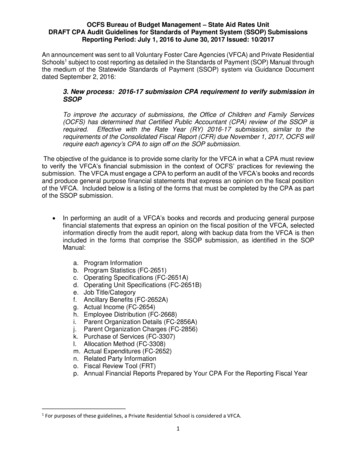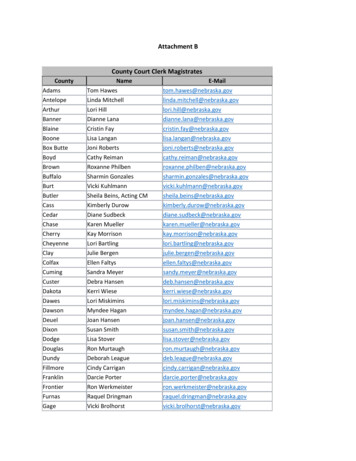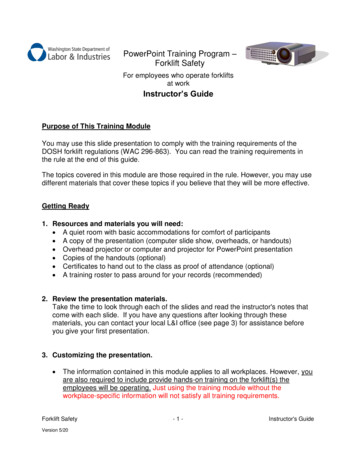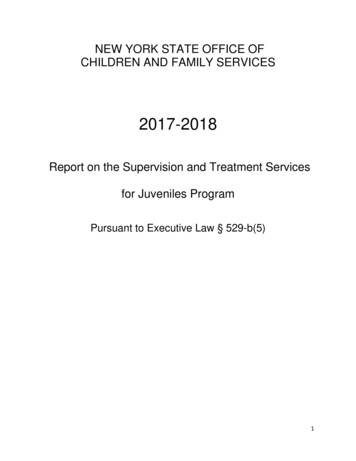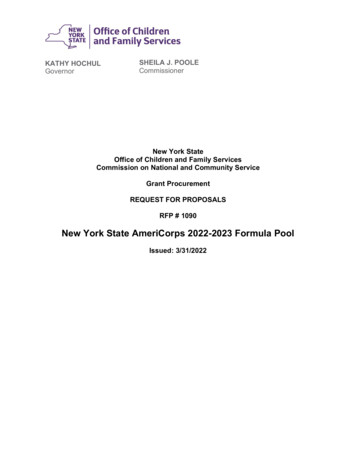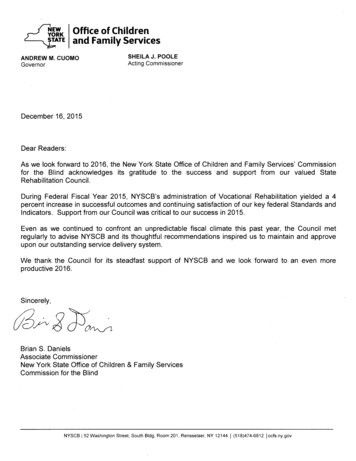
Transcription
omce of ChildrenVILATEand Family ServicesANDREW M. CUOMOSHEILA J. POOLE Acting CommissionerGovernorDecemberl6,2015Dear Readers:As we look forward to 2016, the New York State Office of Children and Family Services’ Commissionfor the Blind acknowledges its gratitude to the success and support from our valued StateRehabilitation Council.During Federal Fiscal Year 2015, NYSCB’s administration of Vocational Rehabilitation yielded a 4percent increase in successful outcomes and continuing satisfaction of our key federal Standards andIndicators. Support from our Council was critical to our success in 2015.Even as we continued to confront an unpredictable fiscal climate this past year, the Council metregularly to advise NYSCB and its thoughtful recommendations inspired us to maintain and approveupon our outstanding service delivery system.We thank the Council for its steadfast support of NYSCB and we look forward to an even moreproductive 2016.Sincerely,.Brian S. DanielsAssociate CommissionerNew York State Office of Children & Family ServicesCommission for the BlindNYSB I 52 WashIngton Street, South Bldg Room 201, Rensselaer, NY 12144 (518)474.6812 ocb.ny.gov
December 16, 2015The Honorable Andrew CuomoState of New YorkExecutive ChamberState Capitol.Albany, NY 12224Dear Governor Cuomo:As Chairperson of the New York State Rehabilitation Council (SRC) for the New York StateCommission for the Blind (NYSCB) from October 2014 through September 2015, I am pleased topresent for your consideration the FY2014-15 State Rehabilitation Council (SRC) Annual Report.Each year, the SRC produces this report to inform federal and state officials and the public about itswork and accomplishments. This report highlights the SRC’s activities for FY2014-15 and the goals forFY2OI 5.46.The SRC works in partnership with all of the key stakeholders responding to the needs of New Yorkerswho are blind andlor visually impaired. While the SRC as a whole has a well-defined purpose, ourinfluence does not come merely from legal or regulatory mandates. Instead, our influence comes fromthe completion of our key work. Each member serves as the voice of the constituencies which helsherepresents, and with that voice, each represents the voice of many.Should you have any questions or require additional information, please feel free to contact me at anytime.Respectfully submitted, 2LLzNYSCB SRC Chairpersoncc: Edward Anthony, Deputy Commissioner, Rehabilitation Services AdministrationDavid Miller, State Liaison, Rehabilitation Services AdministrationTracy Breslin, SRC Coordinatorluaison, NYSCB
December 16, 2015Mr. Edward Anthoqy, Deputy CommissionerRehabilitation Services Administrationus Department of EducationMary E. Switzer Building400 Maryland Avenue, SWWashington, DC 20202Dear Deputy Commissioner Anthony:As Chairperson of the New York State Rehabilitation Council (SRC) for the New York StateCommission for the Blind (NYSCB) fromOctober 2014 through September 2015, I am pleasedto present for your consideration the FY2014-15 State Rehabilitation Council (SRC) AnnualReport.Each year, the SRC produces this report to inform federal and state officials and the publicabout its work and accomplishments. This report highlights the SRC’s activities for FY2014-15and the goals for FY2OI 5-1 6.The SRC works in partnership with all of the key stakeholders responding to the needs of NewYorkers who are blind and/or visually impaired. Each member, as does the SRC as a whole,has a well-defined purpose, but our influence does not come merely from legal or regulatorymandates. Our influence comes from the completion of our key work. Each member serves asthe voice of the constituencies which he/she represents, and with that voice, each representsthe voice of many.Should you have any questions or require additional information, please feel free to contact meat any time.Respectfully submitted,Pratik PatelNYSCB SRC Chairpersoncc: David Miller, State Liaison, Rehabilitation Services AdministrationTracy Breslin, SRC Coordinator/Liaison, NYSCB.
—C,C)0—sII—s——S
Introduction. The State Rehabilitation Council (SRC) for the New York State Office of Qhildren and FamilyServices’ New York State Commissionfor the Blind (NYSCB) is pleased to issue its AnnualReport for the Fiscal Year 201 5 to Governor Andrew Cuomo and Deputy CommissionerEdwardAnthony of the Rehabilitation Services Administration. This report includes anoverview of the Council’s activities during FY 201 5 and outlines the SRC’s plans for theupcoming year FY 2016.The State Rehabilitation Council is an advisory body mandated by Section 1 05 of theRehabilitation Act of 1973, as amended. The nature and scope ofthe Council’s deliberationsand recommendations include NYSCB policies, procçdures, and operations as they may affectconsumers or applicants for agency services statewide. AddWonall, the SRC assists in thedevelopment of federally required State plans and annual updates to those plans. Much of theCouncil’s business has beenconducted in committees via conference calls which focus on theNYSCB priority areas of workforce development, quality assurance, policy, procedure andplanning as well as SRC membership. The SRC holds its meetings once each calendarquarter.The Council is comprised of members representing consumers who are blind, consumers whoare deaf-blind, parents, educators, the Client Assistance Program, Section 121 NativeAnièrican Rehabilitation Programs, the State Educational Agency, business, industry andlabor, consumer advocacy groups, the New York State Workforce Investment Board, and theNew York State Independent Living Council. Ex-Officio members represent Adult Career andContinuing Education Services-Vocational Rehabilitation (ACCES-VR) and variousrepresentatives from NYSCB who provide information and assistance as requested by theCouncil. Meetings are open to the public and always include a public comment segment duringwhich indMduals are invited to provide input or bring issues of concern to the Council’sattention.
Functions of the State Rehabilitation Council (as stated in Section105 of the Rehabilitation Act)The Council shall, after consulting with the State Workforce Investment Board1. Review, analyze, and advise the designated State unit regarding the performance ofthe responsibilities of the unit under this title, particularly iesponsibilities related to:a. eligibility (including order of selection)b. the extent, scope, and effectiveness of services provided; andc. functions performed by State agencies that affect or that potentially affect theability of individuals with disabilities in achieving employment outcomes underthis title;—2. In partnership with the designated State unita. develop, agree to, and review State goals and priorities in accordance withsection 101 (a)(15) (C); andb. evaluate the effectiveness of the vocational rehabilitation program and submitreports of progress to the Commissioner in accordance with sectionI 01 (a)(1 5)(E);3. Advise the designated State agency and the designated State unit regardingactivities authorized to be carried out under this title, and assist in the preparation ofthe State plan and amendments to the plan, applications, reports, needsassessments, and evaluations required by this title;a. To the extent feasible, conduct a review and analysis of the. effectiveness of,and consumer satisfaction with the functions perFormed by the designatedState agencyb. vocational rehabilitation services provided by State agencies and other publicand private entities responsible for providing vocational rehabilitation servicesto indMduals with disabilities under this Act; andc. employment outcomes achieved by eligible individuals receiving servicesunder this title, includingthe availability.of health and other employmentbenefits in connection with such employment outcomes;4. Prepare and submit an annual report to the Govemor and the Commissioner on thestatus of vocational rehabilitation programs operated within the State, and make thereport available to the public;5. To avoid duplication of efforts and enhance the number of indMduals served,coordinate activities with the activities of other Councils within the State, includingthe Statewide Independent Living Council established under section 705, theadvisory panel established under section 612(a)(21) of the Individuals withDisabilities Act (as amended by section 101 of the Individuals with Disabilities
Education Act Amendments of I 997; Public Law I 05-1 7, the State DevelopmentalDisabilities Council described in section 124 of the Developmental DisabilitiesAssistance and Bill of Rights Act (42 U.S.C. 6024), the State mental health planningCouncil established under section 1914 (a) of the Public Health Service Act (42U.S.C. 300x-4(a)), and the State workforce investment board;6. Provide for coordination and the establishment of working relationships between thedesignated State agency and the Statewide Independent Living Council and centersfor independent living within the state; and7. Perform such other functions consistent with the purpose of this title, as the State1 that are comparable to theRehabilitation Council determines to be appropriateother functions performed by the Council.
Meeting Highhghts and Activities for FY 2015Listed below are meeting highlights and activities for FY 2015 (including participation in thedevelopment of the 2016 State Plan, recommendations, public forums, communication with NYSCBExecutive Board, as well as presentations) that the SRC participated in throughout the year.The fiscal year began with the first quarterly meeting on November 19, 2014. The Chair and Vice Chairwelcomed the members back for FY 2015.H ighlights of Significant ActivitiesAs reported in our FY 2014 report, the Council intended to focus on ensuring that it had fullrepresentation from a diverse group of members, representing various constituent interests related topeople who are bland visually impaired and deaf-blind throughout New York State We are pleased toreport that, in close collaboration with the Governor’s office, The State Rehabilitation Council forNYSCB has more representation than it has in the recent past. The council comprises of 13 membersincluding ex officio members. With the appointment expected to be finalized for two new members bythe first meeting of FY 2016, we will be pleased to have 15 members on the Council. During FY 2016,the SRC will be awaiting the appointment of the representative from the American Council of the Blindof New York, representatives of Business Labor, and Industry, as well as replacements for thosemembers whose terms are expected to expire by the end of 2015.****NySCB is working under a State Plan assurance for full SRC compliance***During FY 2015, the SRC turned its attention to a growing concern that affects employmentopportunities for people who are blind visually impaired or deaf-blind in New York State As the statehas moved to institute new licensing exams for various professions as well as the high schoolequivalency exam more and more of such exams are administered electronically Through its town hallmeetings and community feedback, the council has been following the development of these examswith some concern: In particular, evidence suggests that policies and procedures established by NewYork State Education Department along with third-party contractors who develop and administerelectronic exams, often leave blind and visually impaired test takers with significant disadvantages.Tests are not fully accessible for those individuals who require assistive technology software Policiesand procedures are insufficient for such well-used accommodations as extended time, trained readers,the ability to use multiple formats of exams, or misnormed exams.As a result of this evidence, the Council as a whole intends to focus on making electronic high stakesexams and the accompanying environments for exam administration a focus in FY 2016 and beyondEmploying various tactics for achieving its goal, the SRC will collaborate with NYSCB and other stateagencies to effect change. This will include possible collaboration with Governor’s Executive AdvisoryBoard to NYSCB and the New York State Education Department
Meeting Highlights, SRC Business:The NYS SRC under NYSCB conducts its Council business at four (4) quarterly meetings each year.At each of these meetings, the Council follows an agenda created and proposed by the ExecutiveCommittee. A standard agenda consists of introductions, a report from the Chair, a report from theAssociate Commissioner, presentations, public comment, committee meetings and reports, Councilbusiness and action items. Following is a brief synopsis of the SRC business for each ofthe four (4)quarterly meetings for FY 201 5.Meeting Highlights.for November 19 and 20, 2014At the first meeting in November, the council discussed feedback from the two town hall meetings thatthe SRC and NYSCB conducted in 2014. Among the feedback received was high stakes examadministration, accommodation, and accessibility. The town hall meetings also highlighted particularconcerns with trainings provided by assistive technology centers.In addition, members attending the first quarterly meeting received updates on the pre-college programestablished by NYSCB as well as a presentation on changes expected due to the newly establishedWorkforce Innovation and Opportunity Act (WIOA).Meeting Highlights for March 18 and 19, 2015During the March meeting, the Council reviewed the public feedback received through publicteleconferences that the Commission conducted. Even though a State Plan was not required due toWIOA changes, the feedback was nonetheless received and reviewed. Among the feedback receivedwas need for support groups, additional supports and services for adaptive technology, and questionson the eye registry.The Council worked on one of its significant mandates, the monitoring and pursuing of a consumersatisfaction survey. The initial drafts and strategies for full community inclusion was discussed.The SRC also received updates on the activities of the Blind Enterprise Program as well as theReader’s Aid program.Meeting Highlights for June 17 and 18,2015As a few new members had joined the Council in FY 2014 and 2015, the SRC found it appropriate toinvite a speaker who could provide a presentation on the history and expected activities of the SRC.The Council received updates on the Equipment Loan Closet as well as information on how assistivetechnology is granted to consumers.
The Council participated in a presentation and a follow up discussion regarding high stakes testingaccessibility. As discussed in the section above, the SRC’s focus on testing accessibility comes fromdiscussions taking place throughout the year.Meeting Highlights for September 16 and 17 2015Over the past few years, the Council has been discussing the role of assistive technology training andthe lack of consistency and quality standards. At the September meeting, the SRC invited DavidAndrews Chief Technology Officer from Minnesota State Services for the Blind who has beenintimately involved in establishing a trainer certification program for assistive technology trainersthroughout the state Discussions after the presentation as well as during follow up the Councildetermined to explore an assistive technology trainer certification program for NYSCB.The SRC spent a significant amount of time at the September meeting discussing the State Plan. Evenif a unified plan was not expected until next year, the SRC provided feedback to NYSCB on its draftplan.SRC made the following recommendations to the State Plan:Attachment 48(b) (2): Coordination with Education OfficialsConsultation and technical assistanceEmphasize the need to teach braille and large print during transition if it has not been done.“Accountability on teaching of assistive technologies.”Attachment 4 10 Comprehensive System of Personnel DevelopmentNYSCB should mandate that counseling staff attend the consumer organizations’ conferences as ameans of better understanding the consumer s point of view as well as having an opportunity to seeand better understand the newest in assistive technology.NYSCB should provide professional development to staff on working with and meeting theneeds of consumers with multiple disabilities with the goal to develop internal capacity andexpertiseAttachment4 11(d)Goal 1 --# 6 include fostering working relationships with DOL and ACCES VR#8- Develop and implement plans to increase training opportunities and middle skills jobs incoordination with ACCES VRGoal 2- Strategy #4 should include ACCES VR and Department of Labor as well as local chamber ofCommerce as partners.
In the reference to ATC contractors: a provision for continued required training of the contractors on ATand new devices should be added.Goal 3 #7: Provide targeted outreach and education about NYSCB services to eye care, healthcare andother related service providers and raise awareness at respective statewide conferences.Solicit and compile success stories from consumers to promote utilization of services.Assistive Technology discussion:To address the needs of individuals with multiple disabilities (fine motor, mental health, processing andother cognitive disabilities), the SRC recommends the use of a multidisciplinary team approachincluding consultation with service providers specializing in the area of need. This would offer anopportunity to build the internal capacity of the NYSCB providers regarding other disability needs andstrategies for success.Serving youth: explore options to involve families identifying needs, in the evaluation process andidentifying needs for follow-up supports at home -develop some form of ‘how to’ for those supportingyouth at home, school and in the community. (Addresses the collaboration with schools issue asparent)-Attachment 41 I Id) State’s Strategies and Use of Title I Funds for Innovation andExpansion ActivitiesGoal 2: add number (12) “Work with the private agencies to develop Work Incentives Improvement Act(WIIA) ticket to work programs further enhancing and increasing the partnership plus programsthroughout the state.”Goal 4: add number (4) “Invest in the creation of a subsection of outreach within each regional officeresponsible for promoting the NYSCB to community employers.”In Goal (4) add number (5) “Invest in the provision of qualified SSPs to deaf-blind jobseekersthroughout the state.”Attachment 4.11(e) (2): Evaluation and Report of Progress in Achieving Identified Goalsand Priorities and Use of Title I Funds for Innovation and ExpansionGoal 1: Use other than fiscal 2012 as the baseline for 2016 for comparison purposes.Goal 4: Improve services to individuals who are deaf-blind
Add: “Closely coordinate with the current provider of the stat&wide deaf-blind equipment distributionprogram established by the Federal Communications Commission (FCC) through its authority givenunder the 21’s Century Communications and Video Accessibility Act (CVAA) in order to ensure thatdeaf-blind consumers are provided all necessary equipment and training.(Note that this program ensures that Commission utilizes aN community resources to takeadvantage of carnal funds.)identity how a broad range of assistive technology services and assistive technology devices will beprovided to individuals with disabilities at each stage of the rehabilitation process; and describe howassistive technology services and devices will be provided to individuals with disabilities on a statewidebasis.Add: “investigate the creation of a state-wide assistive technology trainer certification program in orderto harmonize technology skills throughout all assistive technology trainers in New York State.Collaborate with states such as Minnesota and Texas that have placed such programs into effect.”Presentations by Associate commissioner Brian S. Daniels:The following reportswere provided by Associate Commissioner Daniels during the SRCmeetings:November 2014.Commissioner Daniels reported on significant staff changes at the Commission including theretirement of Janice O’Connor, Mary Ann vanAlstyne, and the pending retirement of otherstaff expected over the next five years. Plans for replacements were discussed including theobtaining of waivers for hiring needed replacements. He emphasized the need for continued collaboration with The American Council of the Blindof New York and the National Federation of the Blind of New York—especially in light of thefact that these two organizations provide important information for the Commission to holdtown hall meetings. He reported on NYSCB’s efforts to make various high atakes teats accessible includingMarriage and Family Therapy tests. He promised to keep the SRC involved in additionalefforts.March2015 Commissioner Daniels updated the Council on staff vacancies and plans for replacements.In addition, he discussed changes at the Office of Children and Family Services (OCFS) thatmight impact NYSCB.
He reported that a statewide movement to include accessibility language in NYS contractsto purchase and develop software and technology is being pursued.He further reported that he was selected as a representative on the Employment FirstCommission, which was put together to return recommendations for increasing employmentamong people with disabilities.June2015 Commissioner Daniels reported on new open positions at the NYSCB and existing waiversfor at least 8 posItions. He further reported plans for filling positions for pending retirementsin upcoming months. The Commissioner discussed the recommendations of the Employment First Commissionand that NYSCB would be directly involved in carrying out many provisions oftherecommendations.ement culture within the agency. He further reported that NYSCB was fostering a new managto apply a “lean managemenr philosophy. This would allow managers and staff at theCommission to be agile and nimble in doing their work while learning from their mistakesand minimize resource utilization.Septernber 2015.Commissioner Daniels discussed recent developments with the Ability One Commission andnews in the press regarding Source America, one of the programs that the Ability OneCommissions Oversees. He reported the development of seven principles for operatingsuch programs by a newly developed coalition of organizations.The Commissioner reported on NYSCB’s staffing levels. On the date of the meeting, theCommission stood at I 30. New waivers and positions were pending. The Commissionerreported on new appointments to vacancies he previously discussed with the SRC.He reported that an accessible version of the high school equivalency exam by McGraw Hillwould not be available as anticipated in January 2016.Planned Goals and Activities for FY 2016and each ofThe SRC is scheduled to meet quarterly in FY 2016. In addition, the Executive Committeethe four standing Committees will meet via conference call throughout the year.Assurance,The four standing committees will be: Membership, Policy, Procedure and Planning, Qualitycommitteeand Workforce Development. The new Chair will appoint the chairs and members of eachand will give each its charge.
Goals for FY 2016Below are several goals the SRC plans to work on durIng the next year in addition to its mandatedrequirements. In addition to the general goals listed above, these goals will be addressed by individualcommittees.Membership Commfttee.Goal I : Continue to recruit qualified, diverse candidates to fill new positions or vacancies onthe State Rehabilitation Council.Quality Assurance Committee.Goal 2: Evaluate results of the consumer satisfaction survey and generaterecommendations based on its results.Goal 3: Assist in the development of a tool to evaluate the effectiveness of NYSCB’soutreach efforts to healthcare professionals and pre-service students.Goal 4: Collaborate with the Policy, Procedures, and Planning Committee and NYSCB in thedevelopment of the AT trainer certification program.Policy, Procedures, and Planning Committee.Goal 5: Continue to work dosely with NYSCB on it’s new AT policy to ensure that ATstandards and confidentiality procedures are established.Goal 6: Closely collaborate with NYSCB to include language in all future state contractspertaining to full accessibility of high stakes testing and instructional material.Goal 7: Collaborate with NYSCB and the Quality Assurance Committee to identify, evaluate,and make recommendations based on models of AT trainer certifications throughout thecountry.Workforce Development Committee. Goal 8: Closely work with NYSCB to develop a plan for indMduals impacted by shelteredworkshop closures to be sure they are presented appropriate work opportunities.Goal 9: Develop workforce opportunities by creating and maintaining relationshipsthroughout NYSCB district offices and agencies for the blind in New York State.Goal 10: Develop a three-year plan for increasing workforce opportunities (includingimprovement of interagency collaboration among Department of Labor, NYSCB, andACCES-VR as well as plan for disseminating information regarding NYSCB).
Other Planned Activities in FY 2016The Council will participate with NYSCB in developing the State Plan for Federal Fiscal Year 17. Theparticipation will include information gathering from its members’ respective constituencies. The 2017State Plan will incorporate information obtained at the public forums held at the ACB and NFB stateconventions as well as any other public hearings held by NYSCB.The SRC will re-examine its current by-laws to determine whether any amendments or restructuringmay be needed.The SRC vvill continue the orientation and new member training in the future at one of the quarterlymeetings based on the timeliness of appointment each Fiscél Year hereafter.In addition, the SRC will work to strengthen connections with other SRC’s outside New York State, aswell as with the National Coalition of SRC’s and the National Council of State Agencies for the Blind.Further, the SRC will wOrk with NYSCB to develop one or more mentoring programs, as well as othermechanisms to bring New Yorkers who are blind together so that they may learn from and support eachother.Finally, the SRC will work with NYSCB to bring about implementation of the various recommendationsmade by the committees and Council as a whole. Many of the recommendations of the committeesoverlap with each other as well as with those of the NYSCB Executive Board. Communication andbrainstorming among the members of all of these bodies will further refine their recommendations, andthereby result in an across-the-board improvement in services and opportunities for New Yorkers whoare blind or have low vision.
Rehabilitation Council. . During Federal Fiscal Year 2015, NYSCB's administration of Vocational Rehabilitation yielded a 4 . NYSB I 52 WashIngton Street, South Bldg Room 201, Rensselaer, NY 12144 (518)474.6812 ocb.ny.gov. December 16, 2015 The Honorable Andrew Cuomo State of New York Executive Chamber State Capitol. Albany, NY 12224 Dear .
